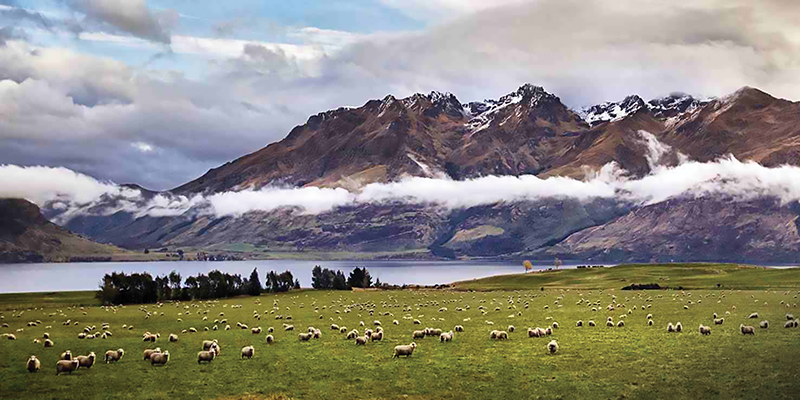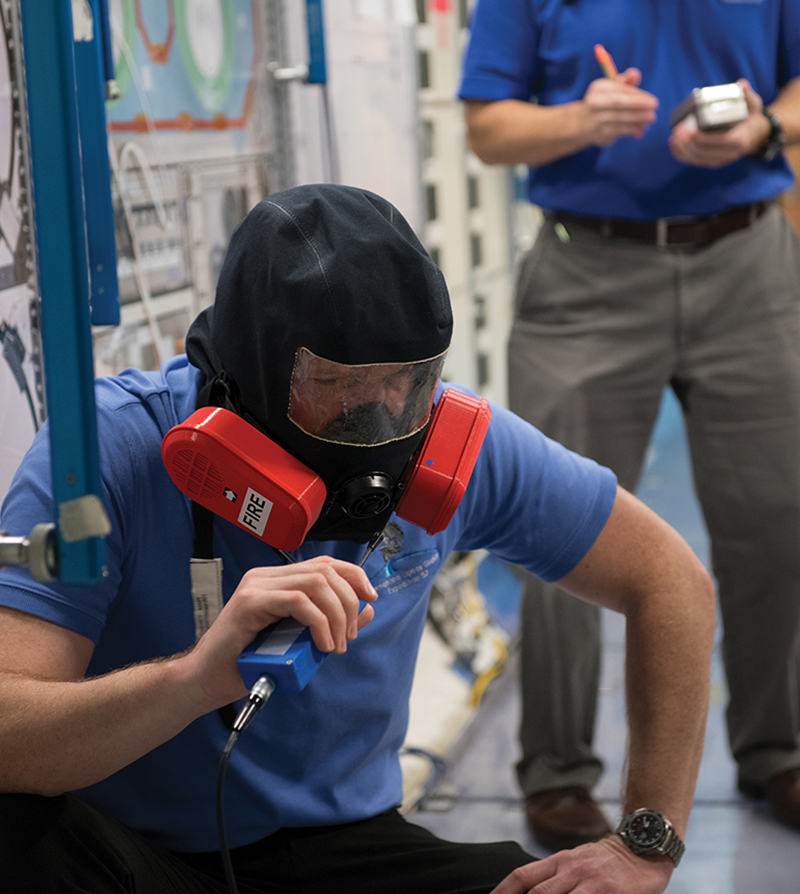
Wool Mask to Fight Fires in Space Inspires Fire Equipment on Earth
NASA Technology
A New Zealand-based company’s work to help astronauts fight fires in case of an anomaly on the Orion spacecraft is already informing its line of wool filters for firefighters on Earth. The work is poised to guide the company’s sheep-breeding program as well.
Astronauts on Orion, NASA’s first crew-carrying space vehicle since the space shuttle, will be equipped with emergency breathing devices that were designed to protect astronauts during a fire on the International Space Station. But fire procedures on the two vessels will differ, so the Space Agency is looking to improve the respirator for Orion—for instance, by making it last longer.
During a fire in space, astronauts are trained to wear respirators while they extinguish the blaze. But any fire would almost certainly release gases and particulates, so it could take hours of cleanup before the air is breathable without a mask.
The emergency breathing device NASA designed for the space station and other spacecraft includes a one-size-fits-all-astronauts (the general population may have a wider range of sizes), fire-resistant mask that can be fitted with a filter cartridge developed specifically for fire. The fire cartridge has 10 layers of filtering materials, including black carbon, co-catalysts, and rayon.
Unlike on station, where, in the event of a fire, astronauts would likely be able to move for a time to another of the numerous habitable modules, astronauts on Orion, a much smaller vehicle, could have to spend more time in a fire-contaminated space.
“Orion is a unique environment,” says Justine Wiles, who is working on the respirator at Jacobs Engineering Group, a contractor at Johnson Space Center in Houston. “We have to adapt what we already have for this new environment.”
Technology Transfer
Jacobs searched around the world for organizations that might have the technical expertise to extend the life of NASA’s current respirator.
In May 2018, a call went out to Lanaco, a New Zealand company that develops and produces wool filter material, with a focus at that point on personal protective equipment in the workspace and air pollution filtration.
The Jacobs team was especially interested in particle filtration, which intrigued Lanaco founder Nick Davenport because, though his company hadn’t been working on emergency breathing devices, he knew wool was well suited to such an application.
Davenport, a materials applications engineer, and his colleagues had noticed the interesting properties of wool while working with polymers about a decade earlier.
“The deeper we dug into the science of wool and how it could perform in an industrial application, using new science, the more we saw there was an opportunity,” he says. Wool is naturally resistant to fire and bacteria, and it manages water well.
Davenport and his colleagues wondered why this extraordinary material wasn’t being used for filtration around the world. They realized air filter technology was focused on synthetic materials, overlooking this natural alternative.
He founded Lanaco and developed his proprietary wool filter technology. The company has built up a specialized commercial flock of sheep by working with a top breeder to maximize the qualities that make good filters and to reduce the material’s variability.
“We analyzed the wool fiber from hundreds of different types of sheep and then established a breeding program to specifically focus on the attributes that we needed to make the world’s best all-natural fiber air filter for respiratory applications,” Davenport says.
Wiles and her team at Jacobs were looking specifically for a prefilter that could fit over NASA’s existing fire cartridge to increase the life of the system for Orion. Lanaco then began to tailor its Helix filter for the application.
The particles that would fly around in the event of a spacecraft fire—including droplets of water used to extinguish a blaze—are potentially small and hot, and the existing technology is typically made of polymers with a relatively low melting point, Davenport says. A product like wool, which doesn’t promote a fire or degrade rapidly under hot particles, has clear advantages.
“As a prefilter, our technology enables the main filter to function in the presence of those hot particles and dangerous gases,” Davenport says.
Lanaco Chief Technology Officer Shaun Tan adds that it “does this by removing the bigger, nastier stuff, like water and toxic components that could stop the main filter from working.”
Benefits
Prior to the NASA contract, Lanaco had not been working directly in the area of critical breathing applications. Now the company has some expertise, with wool performing particularly well in fire resistance and moisture management.
“We have commenced developing some of the features in the NASA application of our filters for use in critical respiratory applications,” says Davenport. He’s creating filters for Fire and Emergency New Zealand applications by testing and prototyping the product with local fire personnel. He expects to have a filter to offer them by 2020.
He says the firefighting services appreciate the ability of Lanaco’s Helix filters to capture coarse, hot particles, filter well in high-moisture environments, and offer the lowest possible resistance to breathing.
“Working on the Orion project and understanding this very unique situation has allowed us to think more closely about how to design filters, specifically as it relates to fires, particles, and hot gases,” Davenport says.
He notes that firefighters fleeing from an encroaching forest fire, for instance, may fear their respiratory gear could actually hinder their breathing while they’re running. They will be more likely to wear a more effective system.
“If we can widen the envelope of performance that is offered to a first responder in a fire, we can certainly help,” he says. “The rigor of our work with the NASA program is directly applicable to the fire service. It informs our formulations and complementary materials.”
Davenport says the work will eventually guide Lanaco’s science and breeding programs as well. He believes it will also continue to inspire consumer confidence in the company’s existing markets, such as personal protective equipment, urban air pollution masks, and air purifiers.
“If it’s good enough for an astronaut to use it, that’s a big builder of confidence,” he says. “It’s a door opener.”

For the Orion spacecraft, NASA is improving the life of the emergency breathing device currently aboard the space station and pictured here during fire training at NASA’s Johnson Space Center. Image courtesy of the European Space Agency

New Zealand-based Lanaco is breeding sheep, pictured here, for its wool filters, which have also benefited from the company’s research on fighting fires in space. The company expects its research on wool filter technology for NASA will eventually inform its sheep-breeding program.













